cognition Final Feldman
1/79
There's no tags or description
Looks like no tags are added yet.
Name | Mastery | Learn | Test | Matching | Spaced |
|---|
No study sessions yet.
80 Terms
syllogism
an instance of a form of reasoning in which a conclusion is drawn (whether validly or not) from two given or assumed propositions (premises), each of which shares a term with the conclusion, and shares a common or middle term not present in the conclusion (e.g., all dogs are animals; all animals have four legs; therefore all dogs have four legs ).
is an argument consisting of exactly three categorical propositions (two premises and a conclusion) in which there appear a total of exactly three categorical terms, each of which is used exactly twice.
A categorical syllogism
Inductive Reasoning
Looking for a pattern or trend and then generalizing, don't necessarily know that is true. Estimating a future population
Deductive Reasoning
Taking known data and starting with facts and deducing other facts
Causal Inference
In a causal inference, one reasons to the conclusion that something is, or is likely to be, the cause of something else. For example, from the fact that one hears the sound of piano music, one may infer that someone is (or was) playing a piano.
Symmetry Formula
distance(a,b) = d(b,a)
What is forgetting?
A.failure to consolidate vs. failure to retrieve
interference among access cues - generally not "decay"
Declarative Memory
Knowledge of Facts
Episodic Memory
personal experiences; subjective point of view
The memories of what you ate for breakfast, your first day of college, and your cousin's wedding are examples of episodic memory. Episodic memory is one of two types of declarative memory.
The long-run value of something is also known as the
Expected Value
What is a "Chunk"
A link to long term memory
A pattern or group
What is the capacity of visual short term memory?
7+/- 2 items, or 3+/- 1 chunks
What stores the sensory experience?
Imagistic Representation
This stores the abstract relation (under(cat,chair)
Propositional Representation
This involves a mental analog of physical rotation and a spatially organized analog of a real picture is progressively transformed
Mental Rotation
Mental rotation allows us to look at an object and be able to flip it, for example, reading a word thats been written backwards.
Why is "Mental Rotation" different from propositional or declarative information?
Because it encodes info that hasn't been verbalized
This is a representation of a visual scene
Stored in long term memory
Retrieved and placed in a short-term visual buffer
Examined by the visual system
Mental Image
This allows us to be able to visualize something or someplace without actually being there, for example, the aisle in the grocery store that has cereal.
Mental scanning
These are representations of mental images are quasi-pictorial analogs of real images
Evaluation is performed by part of the visual system
Mental Imagery (Kosslyn)
This includes representations of images which are propositional or descriptive
scanning time results are due to cognitive expectations of subjects
Mental Imagery (pylyshyn)
According to Locke and Freud, where is knowledge is stored?
Associations or the "Associations Network"
Describe the Semantic Network and who is responsible for it?
Collins and Quillian semantic network: superordinate to subordinate - living thing -> is_a animal -> is_a bird -> robin -> has_property red, sings
what is the Triangle Inequality formula?
shortest distance between two points on a straight line
d(a,b) + d(b,c) >/= d(a,c)
Does similarity obey the distance axioms?
No (symmetry and triangle inequality)
Featural similarity can be __________ and can ______ the triangle inequality, like
asymmetric, violate - like human similarity judgments
Chomsky's review of Skinner's Verbal Behavior argued
The infinite compositionality and productivity of language makes his explanation inadequate
Going from premises (existing beliefs) to conclusions (new beliefs) is known as
reasoning
This describes someone who knows how to distinguish sentences from non-sentences.
Competent
the abstract knowledge held by a "competent" speaker of the language:
Performance is defined as
(how it works in practice): the details that deviate from the ideal competence, and the actual mechanisms for carrying it out (speaking and understanding)
What am I supposed to say next pertains to
pragmatics
or practical aspects of conversation
The system for producing all and only the legal structure in the given language is
Generative Grammar
____ ____________ experiments seemed to confirm the "psychological reality" of syntax boundaries.
Tone Localization
Rewrite Rules
describes ways in which certain symbols can be rewritten as other symbols.
for each new phrase, attach it to the existing tree in the simplest way possible is known as the principle of what?
Principle of Minimal Attachment
Individual sound classes (tooth = /t/ /oo/ /th/
are known as
Phonemes
This is known as the construction of words out of units that carry meaning (morphemes)
roots, prefixes, suffixes, affixes
Morphemes
Phonemes are distinguished by a number of parameters which are
Manner of articulation
Place of articulation
Voicing characteristics
bilabial (p,b) vs labiodental (f,v) vs various other types are known as
"Place of articulation"
Meaning and Logical form are known as
Semantics
Prescriptivism v Descriptivism
Prescriptivism = How "should" it work?
Descriptivism = How does it actually work?
Modus Ponens (strait forward deductive reasoning)
Modus Ponens
A → B (if A then B)
A (A is true)
--------
B (B is true)
A is the antecedent
B is the consequent
Modus Tolens (Method of Negation)
Modus Tollens
A → B (if A then B)
~B (B is false)
--------
~A (A is false)
If the consequent is true than what follows?
Nothing
The "WASON" Selection Task does what?
Proves that people aren't good at deduction
According to Laplace Probability Theory is
Laplace (1812): "Probability theory is nothing but common sense reduced to calculation"
Probability of combined propositions
p(A∧B)=probability both A and B are true.
A∧B is a subset of A, so
0≤ p(A∧B)≤p(A)
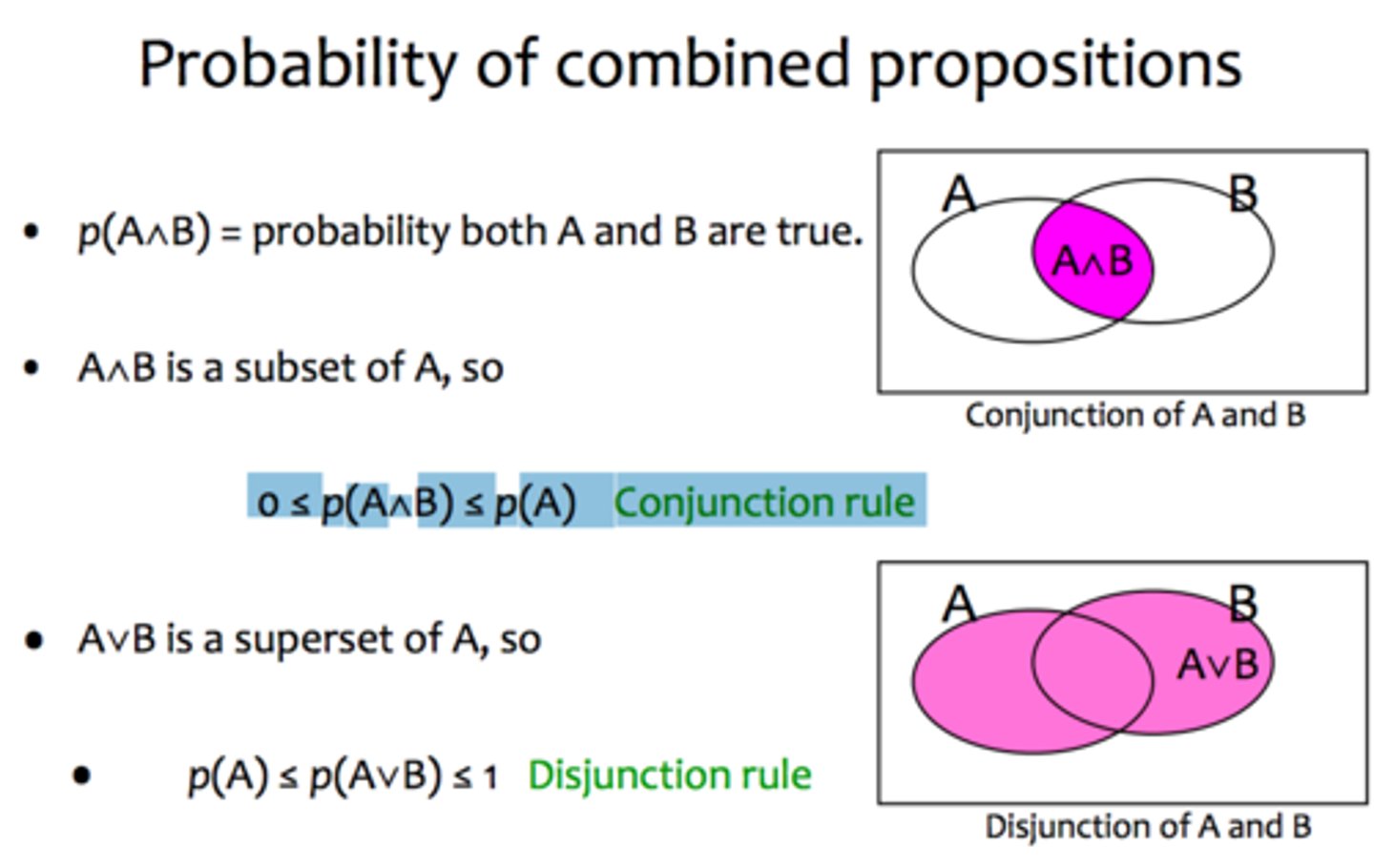
What is the formula for Conditional Probability

Probability
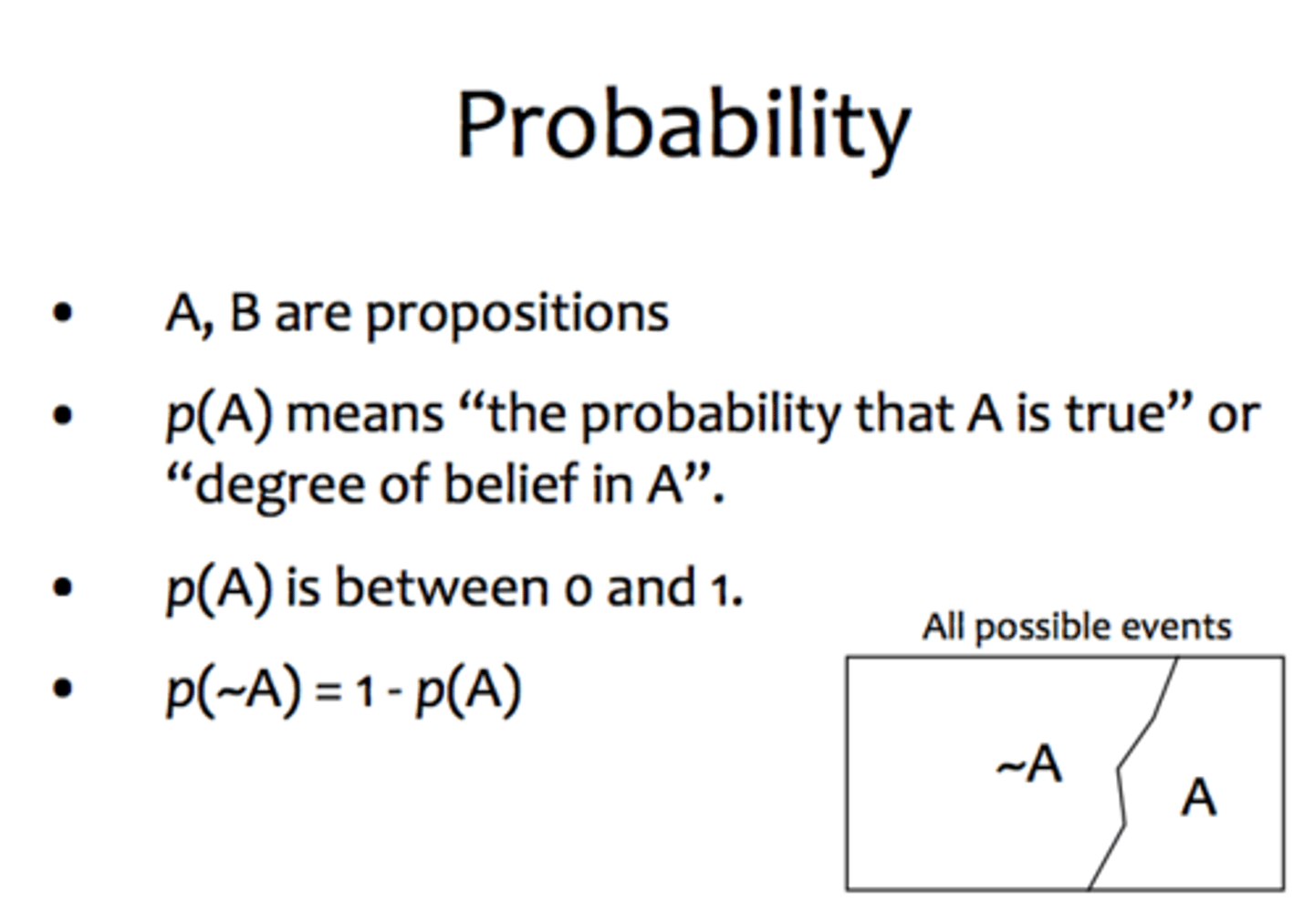
Conjunction Rule Formula
0≤p(A∧B)≤p(A)
Conjunction rule

Disjunction Rule Formula
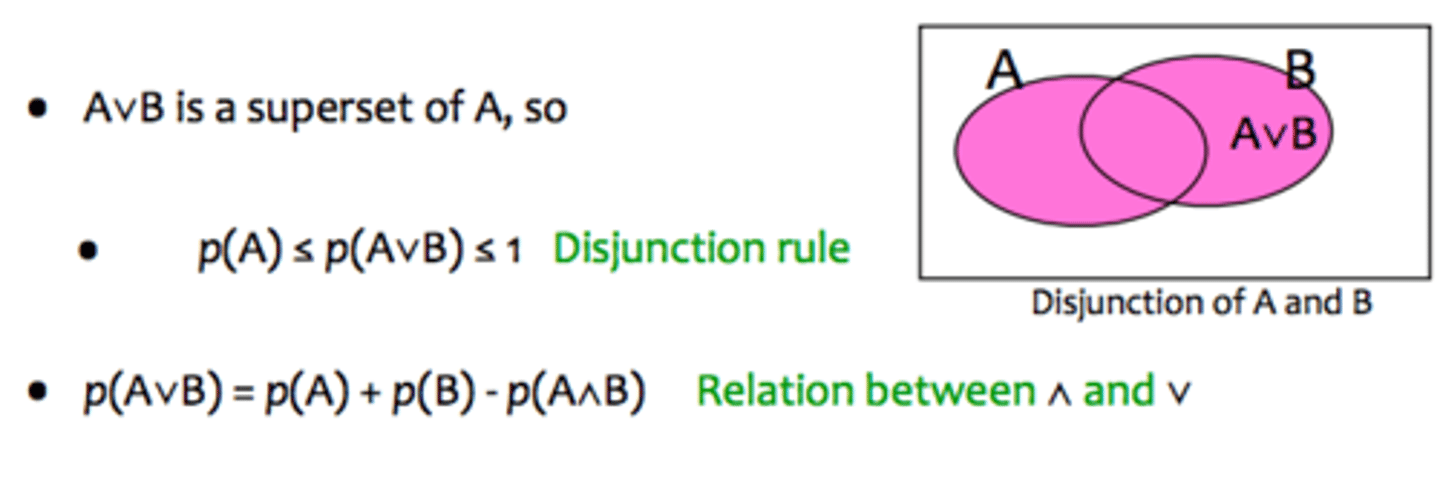
Conditional Probability In Reasoning
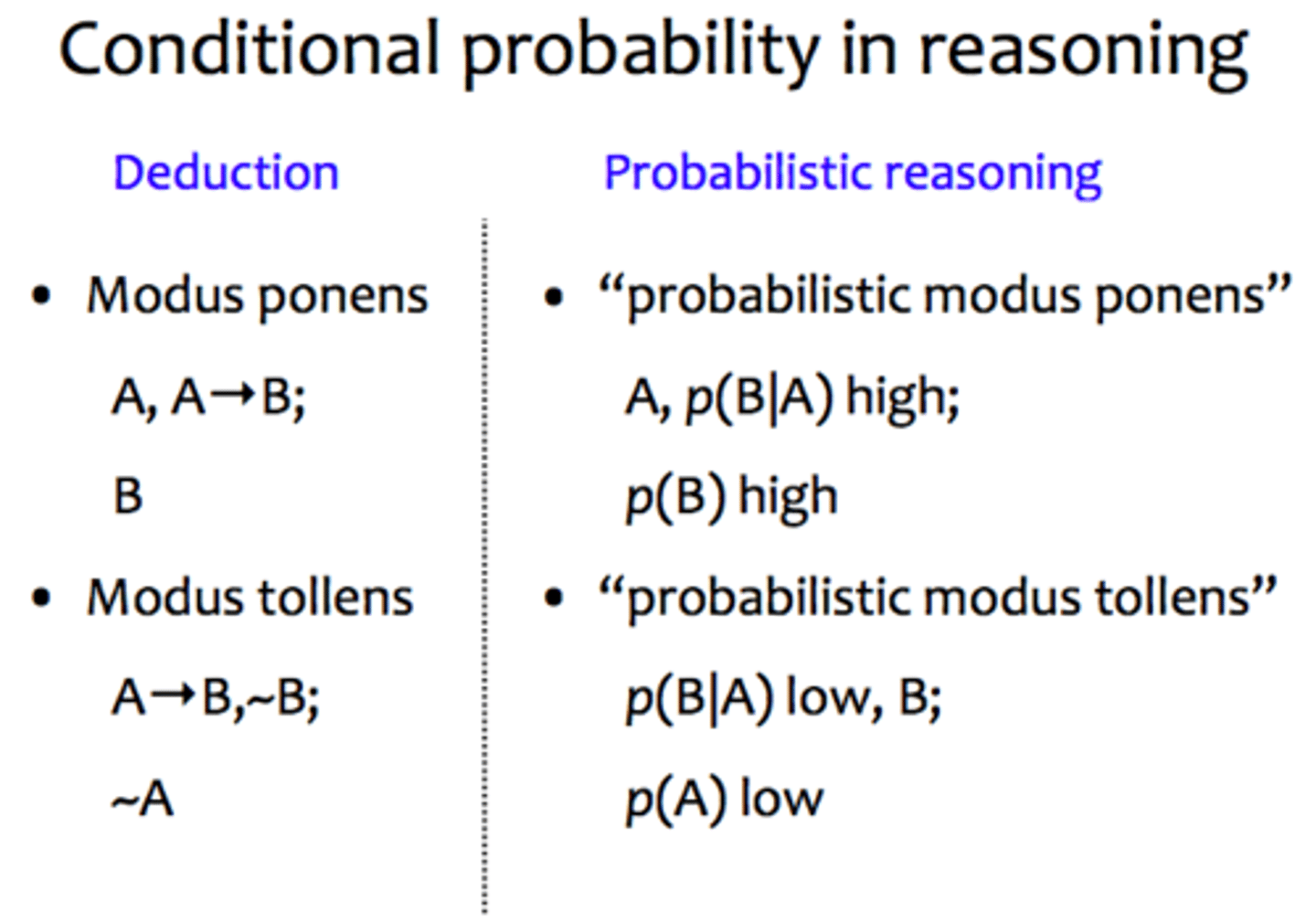
Bayes Rule
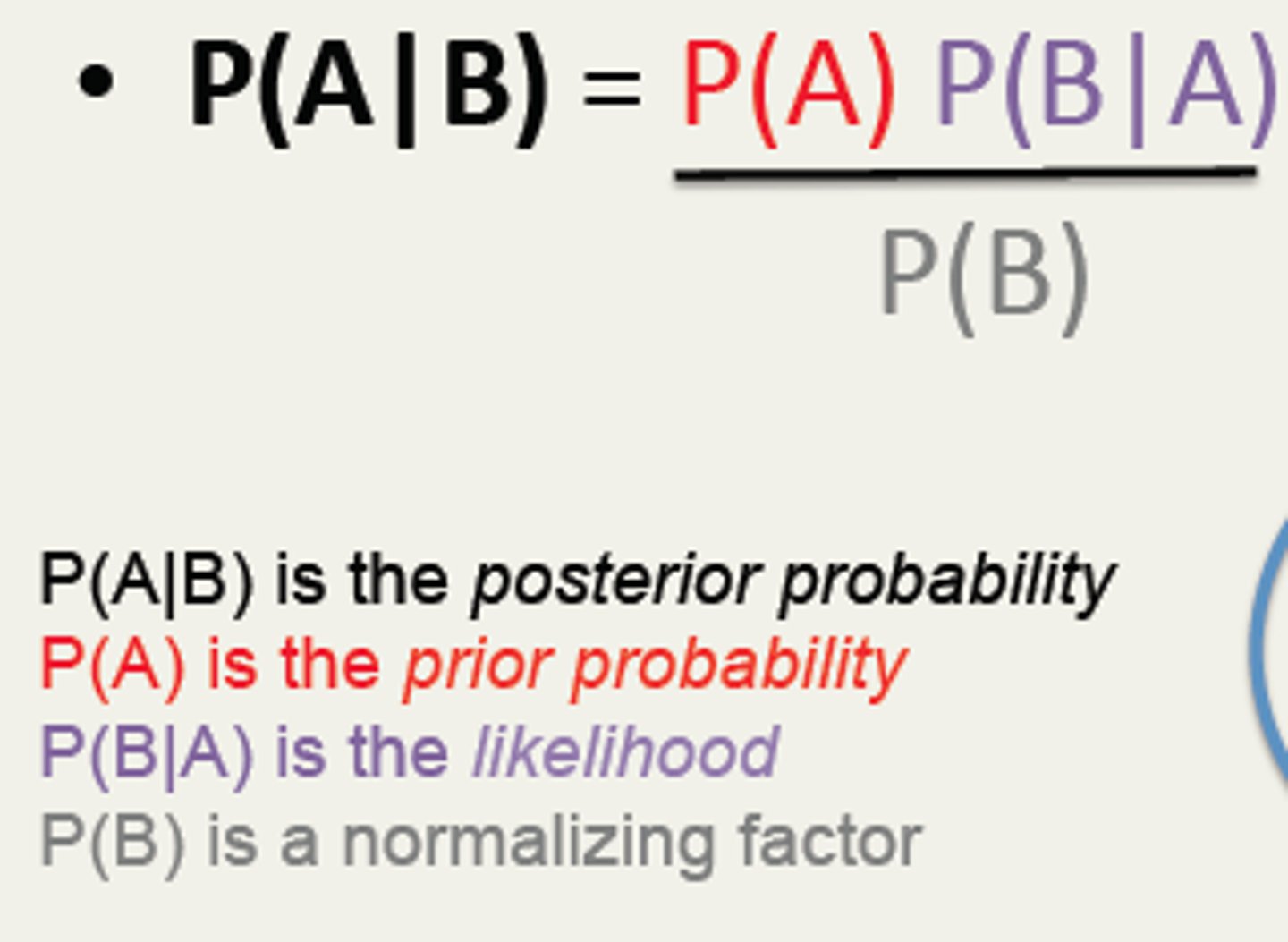
Bayes Rule
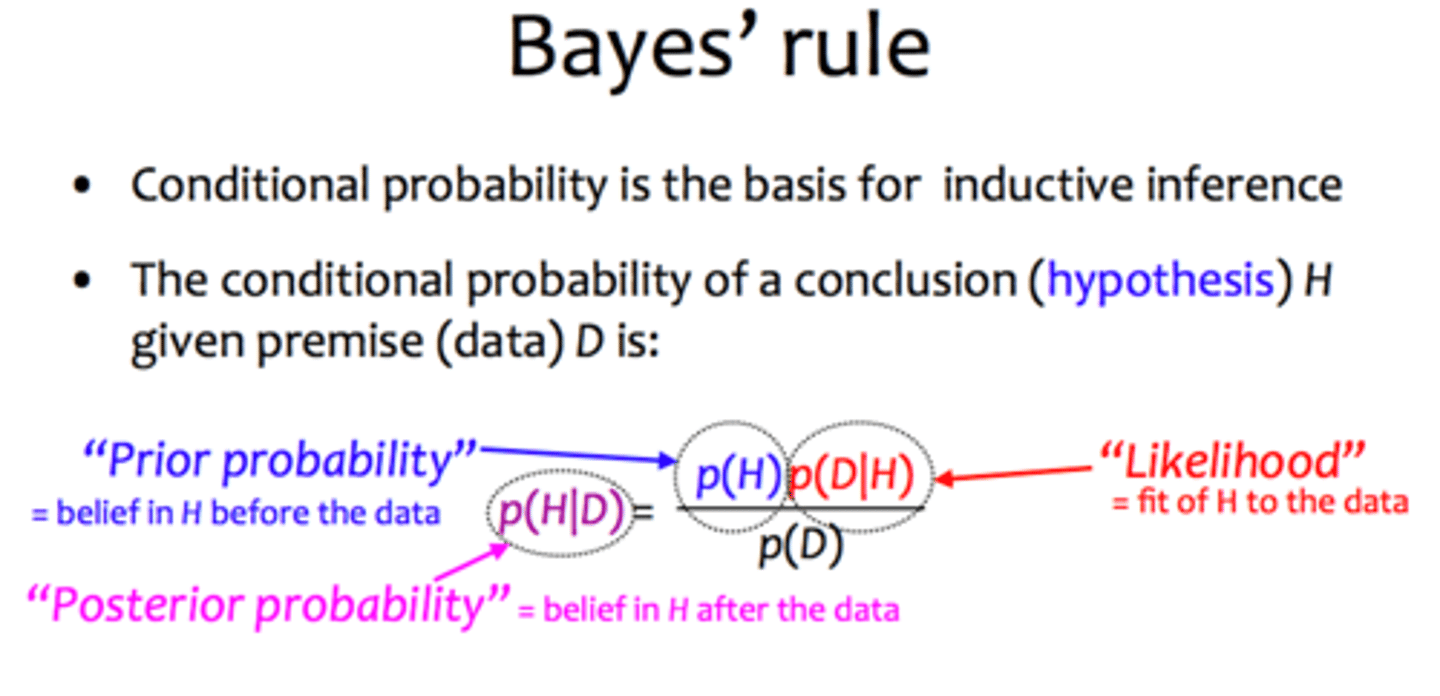
Conditional Probability is the basis for
Inductive Inference
Why is Bayes rule helpful?
Because it is useful deciding how strongly to believe anything or inductive hypothesis on the bases of evidence and prior knowledge.
Bayes Rule Says:
Bayes' rule says: The posterior is proportional to the product of the prior and the likelihood (fit to the evidence).
What is the posterior?
This is how strongly to believe the conclusion with the answer given
Baysian Inference Example (use slide)
A random person, is he or she a democrat?
Prior Probability is p(D) = 58%
OK she's a woman p(D/F)=p(F/D)p(D)/p(F)
p(D/F) same as 31/50 = .62
p(F/D) same as 31/58 = .53
p(D) same as .58
(f) same as .50 0r .5
= (.53)(.58)/(.5) = .615
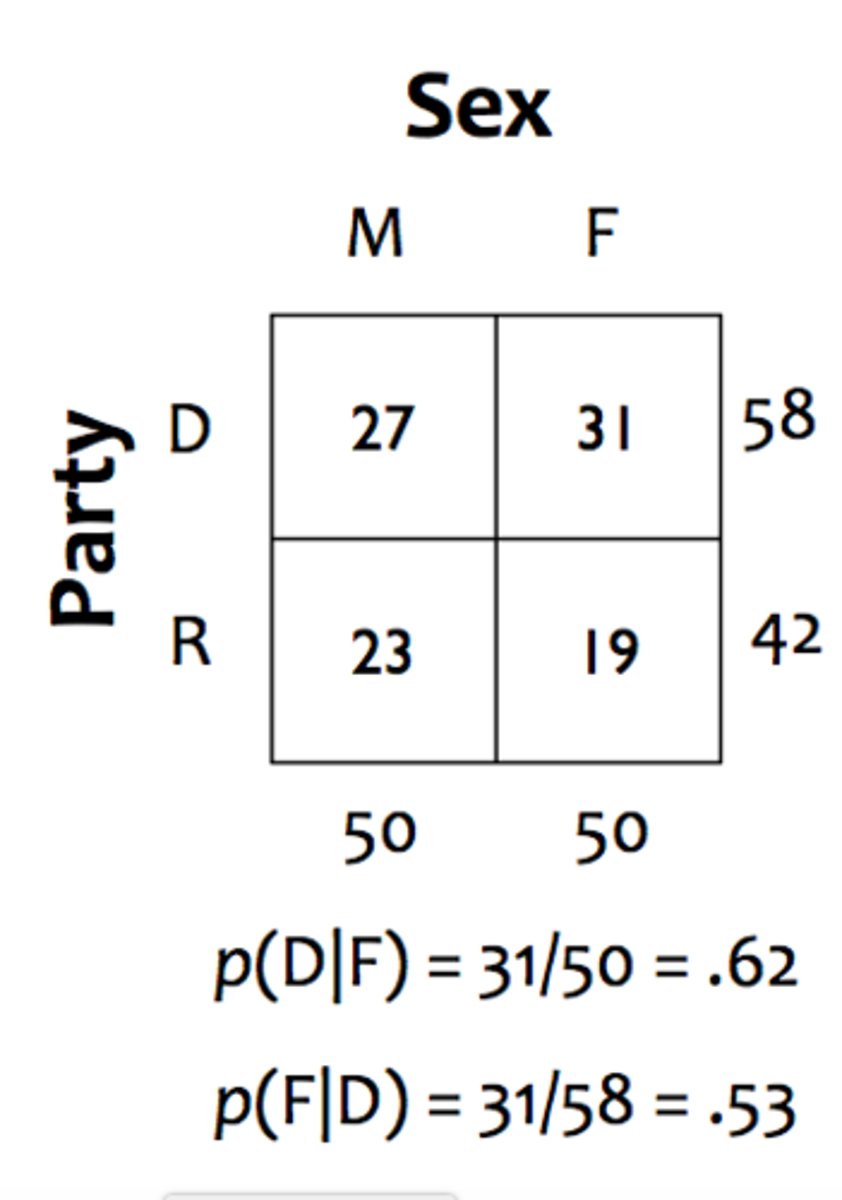
Baysian Inference is considered
Normative and rational
Explain the Conjunction Fallacy
Lady is bank teller
It is more less likely for her to be a feminist and a bank teller because the conjunction of the 2 together is less likely.
What is the common mistake made in the "Base Rate Fallacy"?
People forget to use the prior probability data.
What is the expected value?
Expected value is the long-run average value of something.
What is the formula for expected value?
EV(x) =∑xp(x)
If there is a 50% chance of 1 inch of rain, what is the expected amount
Add up each value of x weighted by its probability:
50% chance of 1 inch of rain = Expected: .5 inches.
EV(x) =∑xp(x)
= (.5)×(1 inch)+(.5)×(0 inches)=.5 inches
What is the Rational price of a bet?
The "rational" price of a bet is its "expected value".
This is considered normative.
Which do you prefer:
100% chance of $10
50% chance of $20
Expected values are the same:
1($10) = .5($20)=$10.
Most people prefer ..
But most people prefer the sure thing (the certain gain).
What about 50% chance of $20
99% chance of winning $12, with 1% of losing $100.
EV = .5($20) = $10.
EV = .99($12) + .01(-$100) = $10.88
What is Subjective Utility?
Subjective utility is how desirable something is to a particular person
This refers to the tendency of people to discount rewards as they approach a temporal horizon in the future or the past (i.e., become so distant in time that they cease to be valuable or to have additive effects).
Temporal Discounting
Are preference reversals rational or irrational
Irrational
What is a preference reversal?
You are given 3 choices.
A, A' and B
Because you can't make up your mind between A and A' you eventually choose B
What is Allia's Paradox?
It's the over weighting of small probabilities
An Example of Allia's Paradox:
Which would you choose?
a 50% chance at $100 or a 100% change at $50?
Most people choose 100% chance at $50 even though they are the same.
An Example of Allia's Paradox:
Which would you choose?
a 5% chance of $100 or 10% chance at $50?
Most people choose the 5% chance at $100 even though they have the same expected value of 5.
Decision Theory is (Expected Utility) which is
rational and normative but not descriptive
When you do the things you want to do but don't consider all the possibilities , this is considered
Satisficing
Satisficing is also known as
Bounded Rationality
This is an example of what?
Choosing a restaurant among a group based only on distance.
Satisficing because you haven't considered any other decision criteria. Politicians do this when campaigning on a specific issue they know voters will consider most important.
This is when we decide on how probable something is based on how available they are based in imagination.
Availability Heuristic